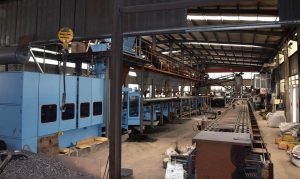Lost foam casting is a popular manufacturing process that involves creating complex parts by using foam patterns. This process is widely used in the automotive, aerospace, and industrial sectors due to its ability to produce high-quality, intricate parts with minimal waste. In this article, we will explore lost foam casting parts in detail, including the benefits, applications, and the process involved.
What are Lost Foam Casting Parts?
Lost foam casting parts are components that are manufactured using the lost foam casting process. This process involves creating a foam pattern of the desired part, coating it with a refractory material, and then pouring molten metal into the mold. The foam pattern evaporates upon contact with the molten metal, leaving behind a cavity that is an exact replica of the pattern. The molten metal then solidifies to form the final part.
Benefits of Lost Foam Casting Parts
Lost foam casting parts offer several benefits over other manufacturing processes. Some of the advantages of lost foam casting parts include:
1. Design Flexibility: Lost foam casting allows for the creation of complex parts with intricate designs that would be difficult or impossible to produce using other methods.
2. Reduced Waste: The lost foam casting process generates minimal waste, as the foam pattern is the only material that is lost during the process.
3. Cost-Effective: Lost foam casting is a cost-effective manufacturing process, as it requires less tooling and equipment than other methods.
4. Improved Surface Finish: Lost foam casting parts have a smooth surface finish that requires minimal post-processing.
Applications of Lost Foam Casting Parts
Lost foam casting parts are used in a wide range of applications across various industries. Some of the common applications of lost foam casting parts include:
1. Automotive: Lost foam casting parts are used in the automotive industry to manufacture engine blocks, cylinder heads, and other components.
2. Aerospace: Lost foam casting parts are used in the aerospace industry to manufacture turbine blades, impellers, and other components.
3. Industrial: Lost foam casting parts are used in the industrial sector to manufacture pumps, valves, and other components.
The Lost Foam Casting Process
The lost foam casting process involves several steps, including:
1. Pattern Creation: The first step in the lost foam casting process is to create a foam pattern of the desired part. This can be done using CNC machines, 3D printers, or by hand.
2. Coating: The foam pattern is then coated with a refractory material, such as ceramic, to create a shell around the pattern.
3. Pouring: Molten metal is then poured into the mold, causing the foam pattern to evaporate and leaving behind a cavity that is an exact replica of the pattern.
4. Cooling: The molten metal is allowed to cool and solidify, forming the final part.
5. Finishing: The final part is then removed from the mold and any excess material is removed through post-processing, such as sandblasting or grinding.
Quality Control in Lost Foam Casting Parts
Quality control is an essential aspect of lost foam casting parts manufacturing. Quality control measures include:
1. Inspection of the foam pattern for defects before coating.
2. Inspection of the refractory coating for uniformity and thickness.
3. Inspection of the final part for dimensional accuracy, surface finish, and defects.
Special attention should be paid to the following points in lost foam casting:
During pouring, the molten metal should always fill the sprue. If the strength of the coating layer is difficult to support due to insufficient metal liquid, it is likely to cause box collapse or air entry, resulting in casting production defects.
Reasonably control the pouring speed. When pouring molten metal, pay attention to the speed. In general, a slow, fast, and slow pace is chosen, which not only avoids mixing air during pouring, but also effectively ends the process and minimizes the waste of molten metal as much as possible.
Try to avoid backspraying as much as possible. Back spraying is a common phenomenon in lost foam casting, and in severe cases, it may endanger the life safety of the pouring worker. Therefore, when using EPC process for production, the selection of foam model must be appropriate, and ensure that the operation process complies with relevant regulations.









-1.png)

-3-300x249.png)

